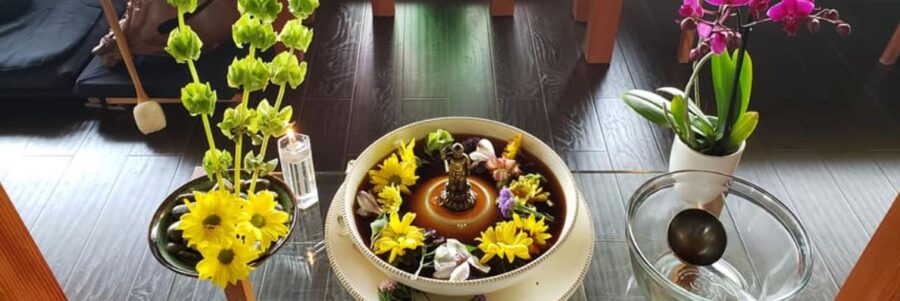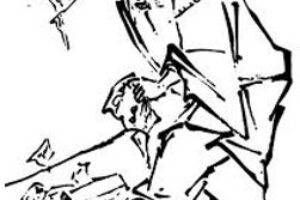Usually, “viral Zen” would suggest the process of the pursuit and propagation of Zen practice as analogous to that of epidemiology in general: The notion that there is something being transmitted that is below or beyond the threshold of perception; that it requires a carrier host, and face-to-face transmission to its next victim, etc. In order to understand the analogy a bit better, I looked up viruses on the Internet and found the following:
Can viruses reproduce on their own?
A virus is a microscopic particle that can infect the cells of a biological organism. Viruses can only replicate themselves by infecting a host cell and therefore cannot reproduce on their own. … It has been argued extensively whether viruses are living organisms.
What are the characteristics of a virus?
Viruses are infectious agents with both living and nonliving characteristics. Living characteristics of viruses include the ability to reproduce – but only in living host cells – and the ability to mutate.
So viruses may be said to be by definition a kind of boundary phenomenon, somewhere between the living and the non-living, at the intersection of organic and inorganic chemistry — which of course are categories invented, or discovered, by humankind. The dominant focus on the new coronavirus epidemic is indicated by the line showing the scope of the search engine’s survey: About 11,880,000,000 results (in 0.68 seconds). Thinking about this situation, two things immediately came to mind — my recently developed model of the four contingent spheres — the personal, social, natural and universal — and certain teachings of Zen. Boundaries between the spheres do not separate them from, but join them to, each other:

Any two-dimensional representation of an n-dimensional reality will obscure as much as it reveals. What is not apparent in the chart illustrated is the intricate interconnection of all four spheres. It seems to suggest that the personal is far from the universal, but actually all four interpenetrate each other on intricate and intimate levels. The vectors of interaction go both ways, our personal actions effectuating influence outward, but the outer dimensions exerting consequential causes and conditions inwardly, upon our individual personal spheres.
The current crisis provides an extreme example of the interface of the personal with the social spheres, and the invasion of both by the natural world. Some may argue that the virus is not a natural-, but a human-caused phenomenon, and there are those who would insist that it is the result of an intentional conspiracy. In any case, it is an example of the universal sphere impinging upon the other three, an anomaly but one that is not truly unique.
That is, the virus is a sub-microscopic assemblage of independent particles of organic matter including DNA or RNA that instructs it to operate much like a wrecking ball. It is not what would ordinarily qualify as “sentient” — exerting a mechanical/chemical demolition upon itself in the process of disrupting the cells of the host animal — nor is it what we usually mean by “natural.” Migrating to humans in the case of Covid-19 apparently as an unintended consequence arising from butchering a bat for purposes of selling meat in an open market in China. I assume that parallels may be found in the plant kingdom.
The first Zen teaching that sprang to mind is from the founder of Soto Zen in China, Dongshan Liangjie, in his liturgical poem, “Hokyo Zammai – Precious Mirror Samadhi”:
So minute it enters where there is no gap
So vast it transcends dimension
[but] a hairsbreadth’s deviation and you are out of tuneWhile speaking of the deep Samadhi to be experienced in Zen, this description sounds analogous to the coronavirus in action, being a minute but ubiquitous particle that is nearly impossible to contain or stop. It becomes capable of crossing nearly all boundaries of nations and geography, riding along with their hosts, the highly mobile human race. Social dimensions of daily life exacerbate the spread of the virus, bringing new and ominous meaning to the last line of the stanza. We can be out of tune, in the sense of losing whatever safety we enjoy from infection, with the slightest deviation from what are, for many, extremely restrictive preventive measures.
We are social animals, and resist giving up our accustomed comforts and pursuit of pleasure, even in the face of a global threat. A related example, highlighted by Buddhism’s traditional practice of celibacy, is the hormonal attraction of sex, which is driven by the trans-personal purpose of the species, reproducing for the purpose of survival. Survival of the species, not the individual, it goes without saying. The spread of STDs, particularly HIV and AIDS, illustrates the power of desire to overcome caution. We are seeing this same heedlessness on a different scale in peoples’ insistence on living the good life as usual, in spite of the dire warnings of experts in public health. This is human nature, which tends to selectively filter information in favor of personal preference.
The coincidence of these seemingly unrelated areas — the impersonal, unconscious world of the virus imploding the social and personal realms of accustomed normalcy, through what must be admitted as a natural process — may be regarded with a sense of irony, or as an example of the ubiquity and comprehensive nature of Buddha’s teachings.

The first of the Four Noble Truths declares that there is no existence exempt from change, commonly translated as “suffering.” The second points out that our personal suffering ensues with craving of all kinds, initiating with the craving for existence itself. This existential catch-22 (a dilemma or difficult circumstance from which there is no escape because of mutually conflicting or dependent conditions — online definition) is at the heart of our personal dilemma when things go wrong, but is always present, in good times or bad. The cessation of suffering is dependent upon our giving up the very self that is the source of craving, which sets up a kind of Mobius-strip, self-fulfilling prophecy, captured by a statement and question from Master Yunju Daoying, and quoted by Master Dogen:
If you want to attain such a thing, you should be such a person. Already being such a person, why worry about such a thing?
This is taken from Dogen’s Extensive Record, translated by Taigen Dan Leighton and Shohaku Okumura, Dharma Hall Discourse #38, “The Difficulty of Such a Thing.” The “thing” under consideration here is the true nature of our person, the awakened Buddha-nature, not the self-nature that we imagine to exist, either in this incarnation or as an eternal soul. In the face of increased suffering brought on by the coronavirus pandemic, we lose sight of the fact that nothing has really changed. Birth is the leading cause of death, and we are constantly faced with danger. No one anywhere is safe. The urgency of this message is not germane only on the social level, but is the single salient defining fact of living beings.
“The Clergy Letter Project,” an online entity that publishes my Dharma Bytes, directed by Michael Zimmerman — mz@theclergyletterproject.org via auth.ccsend.com — recently posted an article that included:
The article ends by saying, “I hope you can find activities that make a difference, both for you and for your community. By focusing on these good actions perhaps we will be able to move past the despair that feels so oppressively heavy right now.”
Despair is certainly understandable in the present circumstances, as is higher anxiety, states of depression, and even the ostrich-like behavior of some cohorts being reported in the news (with apologies to ostriches, who as far as I know, do not really hide their heads in the sand). But according to the Zen view, the current situation is not really atypical of life on the planet, but merely outsized in scale and forced into our active awareness by wall-to-wall media coverage. Not only has the human race survived global threats in the past, but life itself has recovered from nearly total extinction more than once, if we are to believe the geologic record.
The great fear now is that we are witnessing the sixth, “Holocene” or “Anthropocene” extinction, which is thought to be exacerbated, if not basically caused, by the actions of humans, thus the name, in cavalierly tinkering with the environment. Certainly the slowness of response to, and stubborn resistance in accepting the reality of, the current crisis proves the self-defeating nature of postponing the inevitable, typical of human corporate behavior. Fold in the death-wish of some religious fanatics welcoming anything that hastens the Apocalypse. Not to mention the inevitable inertia built into large-scale group dynamics. Individually, we may be capable of turning on a dime, but herding our fellow cats is subject to geometrically expanding chaos, especially when the catherds are in terminal confusion.
While Zen-inspired social protocols really do not prescribe turning our backs on reality, or resorting to Zen meditation as a kind of navel-gazing retreat, as sometimes popularly misconstrued, Zen teachings do tend to emphasize the big picture: The personal and the universal cannot actually be separated, and the social and natural are bounded by them as well. If the present situation seems unsafe, it is because it was never safe, and never will be. But in spite of its hyper-realistic assessment of the true conditions of our existence, we cannot say that Zen is not optimistic, if not in the usual sense of attachment to outcomes:
On the great road of Buddha ancestors there is always unsurpassable practice, continuous and sustained. It forms the circle of the way and is never cut off. Between aspiration, practice, enlightenment, and nirvana, there is not a moment’s gap; continuous practice is the circle of the way — Dogen Zenji
This sign-off, from one of our practice leader’s emails, relates Master Dogen’s fundamental admonition that we practice under any and all circumstances. That in fact the changing conditions of our existence are, themselves, Zen practice. There is no gap in time or in space, or as we would say today, in spacetime. It is not that the conditions we are facing today are just fine; they are wrong and should not be happening. But they are wrong because of behavior of human beings, not the behavior of a virus. Covid 19 is just being the best little virus it can be. It is not conscious of our existence, except as a magnetic attraction to fulfil its destiny. It is not personal. This is a universal principle: “All things are like this” (Dogen).
The meaning of the pursuit of Zen, and the urgency of its practice, does not change throughout spacetime. This is one reason the Four Truths can be considered noble: They do not interact with changing conditions and circumstances. What they are pointing at is naked reality, stripped bare of our pretensions to being the center of the universe. We may be, but only as observers.
The unsentimental nature of Zen’s assessment of our situation, the long view that provides a needed grounding in reality — and what we can do about it, if anything — is captured by Master Dogen in all of his teachings, but with startling vision in this selection from his “Extensive Record,” translated by Taigen Dan Leighton and Shohaku Okumura:
Suchness Beyond Struggle
- 68. Dharma Hall Discourse
Clearly show this to everybody. Directly reaching what has not been realized from the past to the present, from beginningless time there is the actual suchness. Why should we struggle to become always intimate with it?
A footnote explains only that this particular dharma hall discourse, brief live teachings given to his students, was not included in an earlier (1689) version by Manzan Dohaku, without speculating as to why. In lieu of their more expert commentary, I will attempt to clarify what I think Master Dogen is pointing to.
“Clearly show this to everybody” may at one and the same time be an earnest plea for all to have this insight themselves, as well as a call to action to share it with others. “Directly reaching” is the method of Zen meditation, not settling for the words and wisdom of others, but to find out for yourself, reportedly Shakyamuni’s last instructions to his followers. “What has not been realized” may mean that “what” it is not realized, but real; as well as that for most people, it is never realized, even in multiple lifetimes: “the past to the present” of humanity’s brief sojourn on earth.
But — with Dogen there always seems to be a “but” — “from beginningless time” expands the horizon to infinity. And from there and then to here and now, “there is the actual suchness.” What we actualize in our practice may be our personal awareness of this so-called suchness, which word, itself, represents the end of the utility of language, resorting to simply pointing at reality beyond words. “Actual” suchness is not conceptual suchness. Look, look! Can’t you see it? Listen, listen! Can’t you hear it? Can’t you feel it?
“Why should we struggle” was Master Dogen’s initial koan that drove him to China to find an answer. It may mean both: Why do we have to struggle if it — what — is already true and present? Or: Why bother, in the sense that struggling does not seem to be the way “to become always intimate with it.” We are, already, always intimate with it — the what of reality — so it is not possible to become so. But we do not know that we are intimate with it. From time to time, we may think we have a peek in the tent, but it does not last. This is what drives us to struggle to be “always intimate” with it.
Whether we know it or not, we are always in crisis. There is no end to aging, sickness and death, and there is no escape. This does not suggest that we simply “get over it.” We cannot help but do our best to mitigate suffering, but we aspire to transcend it, at the same time.
On the plus potential side, the pandemic seems to be forcing decisive actions that perhaps should already have been pursued — such as changes in voting and income distribution, medical practices and overwrought consumption — and which may have long-lasting, positive effects upon our society.
More on that later, as we witness what unfolds. Meanwhile, please take good care of yourself. Support your Zen center so it will still be there when you come back.









